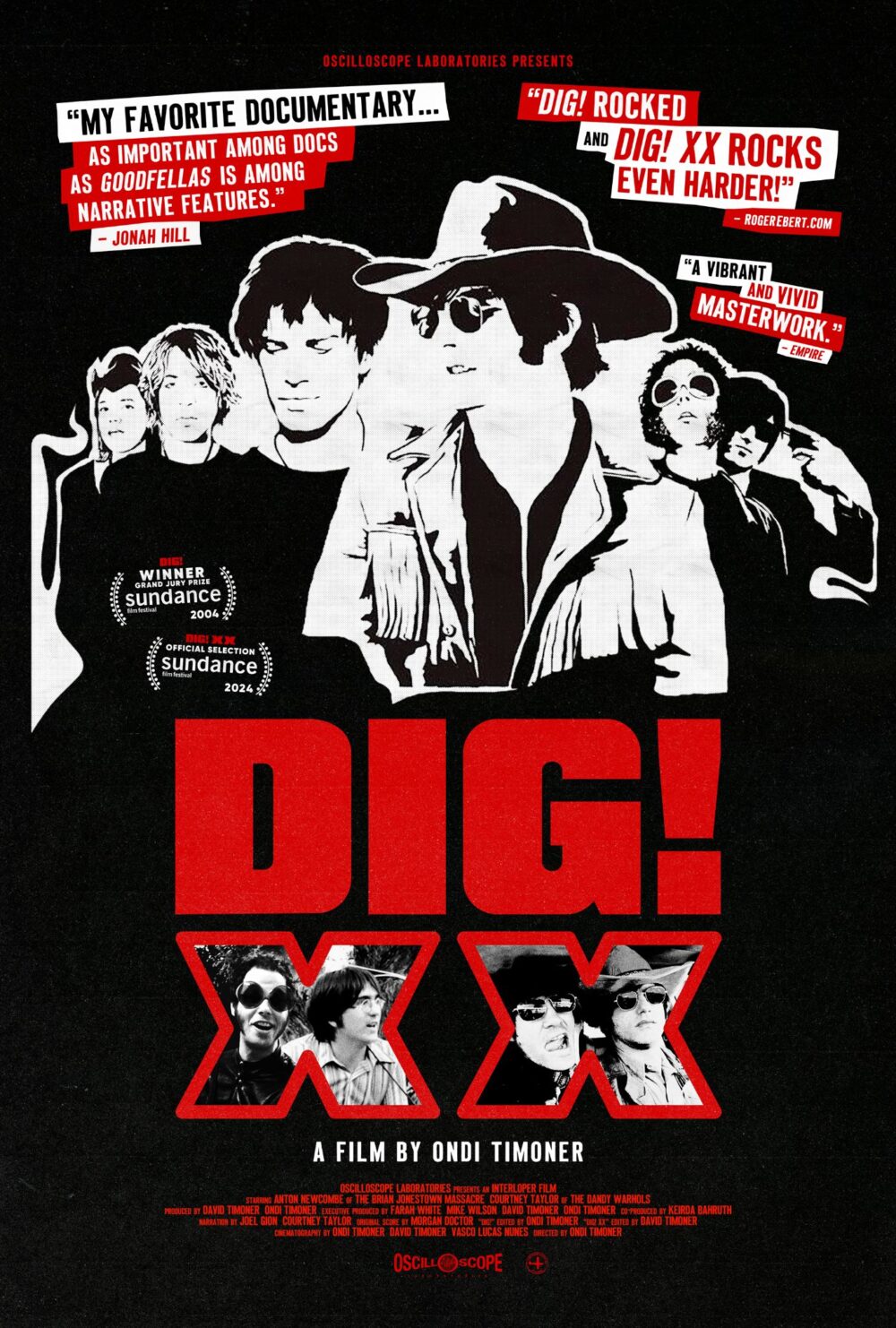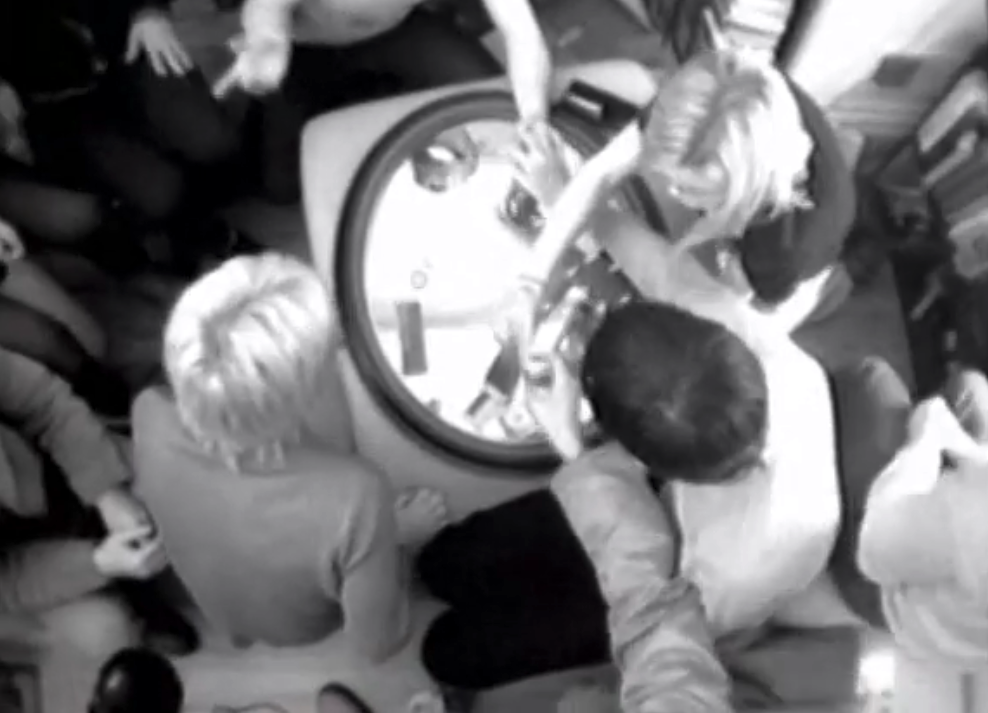Dig! XX Is For The Heads

Let’s face it: You just don’t see celebrities railing line after fat line of cocaine off of mirrored tables anymore. In 2025, the mere implication of hard drugs — even by a party girl avatar like Charli XCX — prompts hand wringing online. Every star, now, is also a de facto role model for some sanitized ideal. But in 1996, when the documentarian Ondi Timoner embarked on her seven-year journey tracking a handful of bands in the West Coast rock scene for the film that would become Dig!, there was no Twitter or Deuxmoi or Oh No They Didn’t! or Perez Hilton keeping score of every suspicious sniffle or strung out diatribe.
In 1996, there were no algorithmic Spotify playlists, no TikTok dance crazes, and few barometers for organic hype other than sold-out shows and head nods from A&R representatives standing at the back of the Troubadour. In 1996, Capitol Records paid somewhere between $8 million and $12 million for a five-year contract with indie stalwarts Matador Records, eager to market the slanted melodies of Pavement and Liz Phair to the masses. In 1996, we were five years into Nielson’s SoundScan, and the music industry was just starting to realize that data might actually be a good predictor of a band’s commercial success. It was, to put it bluntly, the last moment when rock stars were free to be rock stars — burning money on outlandish music videos directed by David LaChapelle, performing on stage in the nude, writing songs about doing drugs and then actually doing the drugs. In 1996, the Dandy Warhols and the Brian Jonestown Massacre were hunched over neat rows of white powder, getting unbelievably high as Timoner captured the debauchery from just a few feet away.

Since its 2004 debut at Sundance, where it won the Documentary Grand Jury Prize, Dig! has become a cult classic for music enthusiasts because it so harrowingly, hilariously, and incisively presents the archetypal rock’n’roll cautionary tale, following the spectacular rise and downfall of psych-rock revivalists the Brian Jonestown Massacre as their friends-turned-rivals in the Dandy Warhols sign to a major label, tour the world, and manage to keep their drug habits (if not their egos) mostly in check. Though Timoner began her film covering almost a dozen bands, it soon becomes clear why she chose to home in on the Dandy Warhols and the Brian Jonestown Massacre. In the world of rock documentaries, Dig! stood out because of its outrageous cast of characters, most of whom were relative unknowns before the film’s debut. It’s almost impossible to script something that encapsulates the creative desires and frustrations of making rock music more succinctly than the Brian Jonestown Massacre frontman Anton Newcombe’s now infamous Viper Room outburst: “He broke my fucking sitar, motherfucker!”
To commemorate its 20th anniversary, Timoner premiered a new, extended edition of the film at last year’s Sundance. Dig! XX was born from a self-professed “more is more” philosophy, adding over forty minutes of clips from the cutting room floor and pairing the film’s original narration from Dandy Warhols frontman Courtney Taylor-Taylor with new commentary from across the aisle via Brian Jonestown Massacre’s tambourine player and court jester Joel Gion. A year after its festival premiere, the extended anniversary cut is coming to theaters across the US and Europe, the first time the footage will find a wide theatrical release, with a wider VOD release on Feb. 25. It’s a reminder of not just a bygone era of rock but of stardom in general, when access was freely given and the self-policing and media training required to succeed in the music business today was scarcely a concern.
I saw Dig! XX in theaters late last month with two friends who had not only never seen the original film but had never previously heard a song by either band (Veronica Mars was just before our time). But as fans of the documentary know, Timoner’s approach, more anthropological study than concert documentary or biography, opens up the world of the Dandy Warhols and the Brian Jonestown Massacre to even casual music fans. In Dig!, Timoner is less concerned with telling the story of the bands than the story of the scene they inhabit and the music industry as a whole.
Almost all the talking head footage in Dig! comes from A&R reps, band managers, entertainment lawyers, and label executives — commentators with enough distance from the bands themselves to offer sober counterparts to the musicians’ volatile personas. In documenting the reality of making a hit (or failing to — “The Dandy Warhols are the reason why people get laid off of record labels,” TVT Records A&R rep Adam Shore laments at one point), Timoner sidesteps the hagiography so commonplace in music documentaries today. With its brave depictions of mental illness, drug abuse, and economic ruin, Dig! almost exists as a different genre of film than, say, The Eras Tour, which was tightly controlled up to the point of distribution by Taylor Swift herself, or Homecoming, which was written, directed, and narrated by its star, Beyoncé.
But then, of course, the Dandy Warhols and Brian Jonestown Massacre aren’t Taylor Swift or Beyoncé. Much of the fun of Dig! comes from watching both the bands and the filmmaker discover their fates along the way, the stakes of even small gigs higher simply due to the precariousness of their artistic futures. At one point, musician, model, part time Jonestowner, and de facto voice of reason Miranda Lee Richards remarks, “All those bands [in the sixties] got into drugs, [but] they were famous first.” Dig! similarly follows that same kind of anti-pattern, documenting musicians before fame tempered their outlandishness or blind faith in their own potential. The closest immediate comparison, though inherently imperfect, might be Coodie & Chike’s 2022 Kanye West documentary Jeen-Yus, which started following the rapper when he was still coming up through Chicago’s music scene and picks up later when his star power seems to have been all but extinguished by his own ego. That series felt similarly wondrous and tragic in its trajectory, tracing Kanye West’s journey from visionary to self-sabotaging recluse.
Dig! XX does not, for obvious reasons, take the same dark turn as Jeen-Yus. As viewers with the benefit of two decades’ hindsight, we know that neither of these bands really “make it big” — that the Dandy Warhols never again reached the commercial success of “We Used To Be Friends” or “Bohemian Like You,” that the Brian Jonestown Massacre never really pulled off the “full-scale revolution” Newcombe preached in the documentary. We know, too, that both bands still make music and perform live, and that, against all odds, Newcombe kicked his heroin habit and tried to clean up his act, if only slightly. Dig! outlives its subjects because it sublimates their petty grievances about writing credits and, yes, sitars into a larger narrative about narcissism and self-aggrandizement, the ways our bad habits can become our defining traits: In one memorable scene, a newly sober Newcombe returns to the stage, but spectators seem hell bent on provoking his infamous ire, at one point throwing fruit on stage while he strummed his guitar, only cheering once he put down the instrument to tear into the audience.
That said, Dig! XX does little to transcend its predecessor, and it’s hard to advocate for anyone but the most diehard Dandy or Jonestown fans to see it as opposed to the 2004 original, which is freely available to stream via the Internet Archive. Though Taylor-Taylor provides the 2004 narration, the original version still fundamentally feels like Timoner’s film, a feat not just in its portrayal of the bands but in its condensing of seven years of filmed material into just over 90 minutes. Though some of the extra scenes in the 2024 edition certainly provide more context for Newcombe’s outbursts — previously unseen lost gigs and intra-band conflicts — the additional material often deflates the movie’s narrative peaks, giving us a bit too much insight into the emotional state of the band, as if to somehow justify or apologize for their antics.
With Gion’s additional commentary from the perspective of the Brian Jonestown Massacre, the film loses the ironic distance it once held from its subjects, with ends that hardly justify their inclusion save for an attempt at “fair coverage” for both bands. Mostly, his remarks consist of the kind of tossed off “fun facts” that might fit on a DVD extras package — “If it was our band, it would’ve been speed, but the Dandies loved their blow, and we were always happy to oblige,” he says as they snort drugs on screen, sounding a little too perfectly rehearsed and pleased by his own recollections. In a band fight that preceded the sitar meltdown at the Viper Room, Gion notes that guitarist Robert Desmond is the “responsible type, seeing an opportunity to be just that.” But we never hear from, let alone really see, Desmond in the rest of the film, rendering Gion’s remarks superfluous and narratively confused at best.
The most rewarding aspects of Dig! XX are the updates we get from the bands at the end of the film. We get to see Courtney Taylor-Taylor grow his floppy faux-hawk into a pair of long braids that would make any “coastal grandmother” seethe with envy. We get to see that yes, the Brian Jonestown Massacre are still getting into physical altercations on stage, even as the members enter their fifties. It feels like a reunion of sorts, a comparatively happy ending to what could have been yet another casualty of the industry.
In a 2023 interview with The Guardian, Newcombe summarized well the fates of not just Dig!’s subjects but the music industry as a whole: “The postscript of Dig! is that the whole industry collapsed.” The machinations of that collapse were already in motion by the time Dig! originally premiered at Sundance. The music industry was just beginning to reckon with the gutting impact of online piracy, and the old days of “major labels los[ing] money on nine out of 10 records,” as A&R rep Adam Shore recalled in the film, were about to come to a close. In Dig!, Timoner documented the last gasp of the music industry’s bullishness.
When the expanded documentary opened with a long, self-congratulatory introduction from a smug and blissful pre-secret-child-out-of-wedlock-scandal Dave Grohl, I almost laughed. The aging rock star was too perfect a metaphor for the ways the genre feels stuck in time, an ossified scene clinging desperately to a halcyon past, real or imagined. But still, it was magical to revisit Dig!, to laugh and gasp and wince at the egotism of it all, even with the knowledge that it captured the twilight of a once-thriving scene. Bands may come and go, but there’s something eternal about watching Anton Newcombe kick some heckler in the head.






